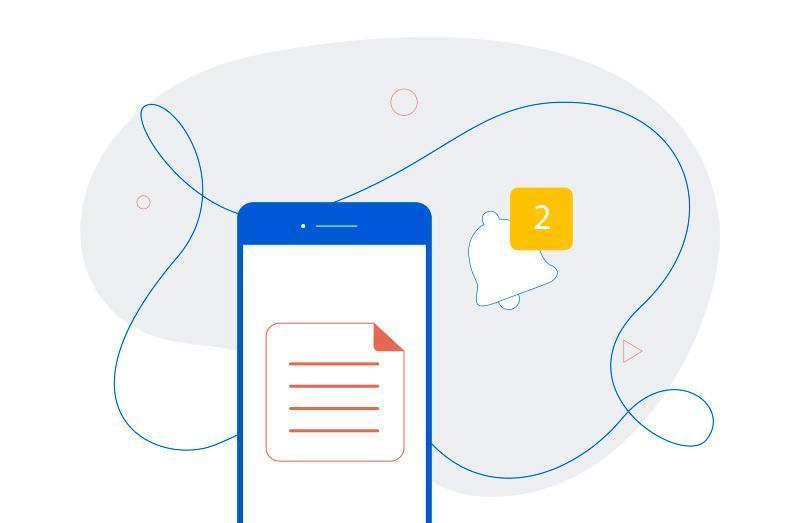You have an e-commerce store and you want to keep up with the market leaders, right? Then it's time to add real-time features to your mobile applications or websites (we hope you have both!).
Perhaps the advice seems too simple to you? It might look this way, however, it's very effective either. All you have to do is find the most efficient approach to using real-time technology in mobile apps and sites.
Read our article to find out what we're talking about. We’ll do our best to prove the point.
What are the real-time features?
So, what’s a real-time feature? Let's try to figure it out to make sure we speak the same language and understand each other.
Firstly, we'd like to note there are relatively static features. For example, a user profile: the user fills it out, and that's that! However, when it comes to examples of real-time features, the situation is rather different. These features react to everything happening around (if it’s somehow connected with a specific user), and that's why they’re so brilliant.
Simply put, the site (or application) with real-time functionality gets the opportunity to deliver the user the most relevant and personalized content based on the constantly updated information on him. The main rule is to act according to circumstances, here and now.
If something is still unclear, don’t worry! You’ll get the key idea of the issue when we move on to a concrete description of the real-time possibilities.
There are different kinds of real-time features but a few things bring all of them together, namely:
-
they target a specific user with his personal history and individual needs;
-
they’re based on changing data;
-
they’re live, updatable, and dynamic.
What is required to integrate real-time features in mobile apps or websites?
-
collecting and analyzing data on each user. All details on the specifics of data analysis will be given later in the article;
-
using mobile & web channels of communication with the user. And if you don’t have a mobile version of your store yet, you had better think about creating it;
-
data protection. You’re dealing with very private user information, and if it is stolen, there is a risk of losing the trust of your customers.
And now let's discuss the benefits of real-time features in mobile apps.
Real-time features benefits
Let's list the benefits you get by developing real-time features in mobile apps (as well as sites):
-
Personalization of content. You provide the user with personalized content focused on his specific needs.
-
Improved user experience. Personalized content solves the user's problems, which means the experience of his interaction with your store has been improving.
-
Better selling. It’s logical to assume that a satisfied user is more prone to shopping. And your sales are growing by leaps and bounds.
-
Increasing brand recognition. Thanks to the real-time functionality, the user memorizes your store faster and better (and on its good side), which leads to the growth of brand awareness.
-
The most relevant information. Your content is always up to date and fresh. And users love it!
-
Promising user base. All of the above increases your user database. And each user is your potential (or a real one) customer.
-
Following the trends. Such a point may seem less significant, but the ability to keep abreast of the times is an important success factor in any industry (including eCommerce).
So, by integrating real-time features in their applications, e-store owners become almost friends of their customers: friends who know what these customers want and are ready to provide each of them with the desired.
Top must-have real-time features
What real-time features in apps and sites do you need? Let’s name the key ones!
Customer support
We should start with the most important thing - supporting your customers. Its significance is determined by the following reasons:
-
consumer dissatisfaction. Let's be honest: in any business, there are ups and downs, and you, too, won't be able to avoid bad moments. From time to time, you'll encounter certain problems and the dissatisfaction of your customers. And it's important to respond to such situations in a real-time manner.
-
assistance in interacting with the online store. Of course, it's better to make sure the interface of your site or application is intuitive and user-friendly, but sometimes even the best UI / UX might confuse someone. Say, perhaps, the user has difficulties with the choice of goods? Or he can't hunt down a question about the delivery terms? Get ready to answer right away!
-
reaction to any feedback. Unlike the first item on the list, we’re now talking not only about negative reviews but also about positive ones. We advise you to actively respond to any user feedback: your consumers should see your attention to their needs.
Consumer Support Format:
-
Real-time chat: applications and sites need such a feature to respond to users' questions and requests as quickly as possible. The ideal option is round-the-clock support. If you don't have the opportunity to find an operator outside the office hours, we recommend using the chatbot at night. A chatbot is a program able to answer the customer using the algorithm embedded in it. If the questions are too complicated and atypical, the chatbot should offer to leave a message, which the manager would answer as soon as he can.
-
Other communication channels. In addition to the feature of real-time messaging services, the functionality should include the possibility to contact you in other ways too: through email, Skype, Viber, etc. Besides, it’d be a good idea to create a page where a person can leave you a message which will then be forwarded to your email address.
-
F.A.Q. Frequently Asked Questions don't belong to real-time features, but we cannot fail to mention the importance of such a section. In the end, it would significantly save you time if the user finds among the already asked questions the one that interests him.

Push notifications
Push notifications are incredibly demanded today. They are good for reminding of your store, reporting some fresh information, etc.
What should the user be notified about? Here are some basic examples:
-
company news: new supply of goods, sale of shelf stocks, and so on;
-
discounts and bonuses. It’s best to create a loyalty program taking into account the interests of a particular user;
-
personalized offers. A good instance: if the item from the user's Wishlist has appeared on sale, he'd be glad to know about it.
-
geolocation. If you have a real store in addition to online and mobile versions, then you may take advantage of geolocation. Imagine: a user walks past your store without knowing it... invite him to come to you (and promise discounts and promotions!).

Recommend products
Recommended products are a very popular feature in modern apps. In fact, it represents the ability to guess the client's wishes and offer him what he's likely to be willing to buy. And the main trick is to understand which strategy is going to help you identify products potentially interesting to a particular shopper.
We suggest paying attention to the following points:
-
Purchase history. The first thing to do is to analyze the user's purchase history. The information received will tell you a lot and help you figure out what exactly is in the range of interests of the consumer, what goods he is used to buying, and so on.
-
Viewed pages. The evolution of real-time technology gives us many opportunities, among other things is a chance to find out which pages the user was viewing (even if he didn’t buy anything). Offer him similar products of different price categories (sometimes the reason for the person’s reluctance to purchase the viewed item is a too high cost). Try it, it should work!
-
Goods to supplement the purchase. Also, you can offer your customer products that are often bought by other users who have bought the same thing. Say, a person purchased a shampoo, and you know that other buyers (who also bought it, but earlier) chose a shower gel of a certain brand as well. Who knows, maybe these goods would also be interesting to the consumer in question?

Live order status
When developing apps with real-time features, don't forget about this one. The live order status is more important than you might think.
After all, a customer has the right to know where he stands. And the customer is your master, so to say. What he wants - he gets!
Order status examples:
-
in process;
-
accepted;
-
packed;
-
sent;
-
on the way;
-
delivered.

Analytics
And, of course, building the application with the real-time features we've described above is impossible without a thorough collection and subsequent analysis of the data.
There are many sources of obtaining user data, among them, the following should be mentioned:
-
information entered by the user when filling out the profile. Therefore, be careful when composing the required fields. Don’t forget anything of importance!
-
social networks. Real-time content on social media can be used in mobile applications and websites. By the by, a good option is to offer the user to simplify the registration process by integrating data from social networks (for example, Facebook). Usually, users are very frank in their pages on social networks, so you get the opportunity to obtain very detailed information on your customers. And one more nice bonus: users would be happy to have a chance to avoid boring filling out fields (a procedure which often annoys them).
-
network behavior. It’s also important to analyze user behavior: which pages he visits, which products he views, etc. This is the best way to understand which products to recommend to him, which notification to send, etc.
So, you have the data, but it’s important to analyze the obtained information and draw the right conclusions. Happily, the web and mobile app development industry offers many tools for high-quality data analysis, you just need to make the optimum choice. And the first thing to take care of is the platform to power your resource by.
Summary
We hope our article helped you understand how real-time features have impacted applications and sites and how you can use such an impact to your advantage.
And now it's up to you! Are you ready to improve your eCommerce resource by adding real-time functionality to it? Then we're happy to assist! And by the by, if you still don't have your own online store (or its mobile version), we'll start the project from scratch.

